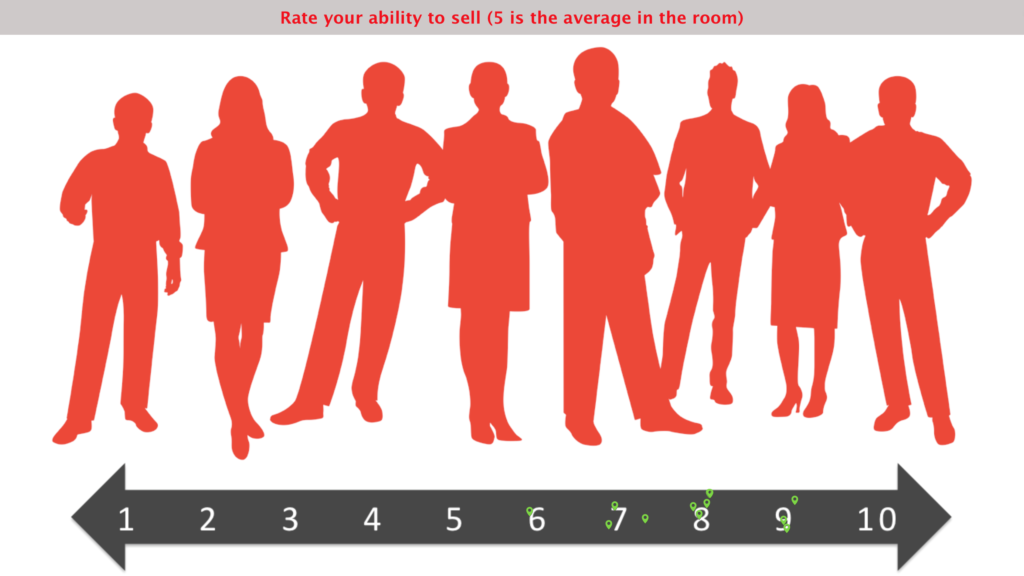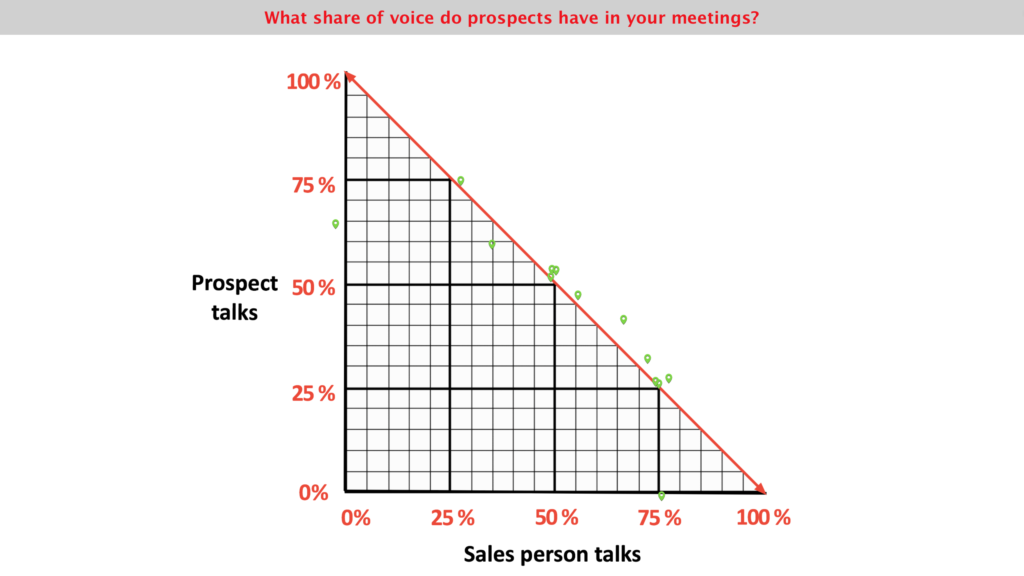We recently polled over 100 sales people to find out what they thought the share of voice was in their sales meetings. The range from the sales people was between 25% and 75%, with the average being 37.5%. Similarly when we asked their sales managers what the share of voice was in their team’s meetings, we got an even more optimistic response that averaged out at 52%.
Salestrong coaches accompanied the sales people on sales meetings and confirmed that the sales people did indeed have the larger share of voice in their sales meetings. The Share of voice we observed in our tag-along meetings was not as high as as 52%, nor 37.5%. It was actually 24%. In other words the customer was talking for less than a quarter of the sales meeting with a sales person.
The Importance of Share of Voice
Why is share of voice so important in sales meetings? We’ve known for some time that share of voice is one of the most significant indicators of sales success. You can broadly divide sales people into ‘Tellers and Sellers’, a phrase made famous by Terri Levine PhD (2000) in The Top Ten Ways to Know You are a Teller or a Seller. ‘Tellers’ talk for more than half of any sales meeting and ‘Sellers’ talk for less than half of any sales meeting.
The reason this is so significant is that when sales people are talking, they can’t be listening at the same time. And of course, the sales person needs to listen so that they can understand the prospect’s situation. If the sales person does not understand the prospect’s idiosyncratic situation, the sales person is just guessing that what they are selling will fit the prospect’s needs. ‘Sellers’ on the other hand spend time listening to the customer, to understand their business, so that they can create value and then communicate that value.
With this particular sales force Salestrong needed to change them from ‘Tellers’ into ‘Sellers’. To do this we recognised that it was not something that an afternoon in a classroom would solve. Firstly, the sales people did not know the extent of the issue; they were unconsciously incompetent. Secondly, the sales managers were unaware of the actual state of affairs. Thirdly, here was a successful sales force with some people who had been in tenure for three decades. Even if they did recognise the need to change, it was going to be a challenge to make that change happen and sustain it over time.
Building Sales Credibility
Given the established nature of the sales force, we needed to really challenge their thinking. We did this by bringing the customer into the classroom, which was done in a number of ways:
1) Firstly, we interviewed a selection of prospects and customers to ask them what they wanted from this salesforce. The customers were clear that they wanted two things:
a. A non salesy approach that this sales force were reknowned for
b. A solution that fitted their individual needs
2) Secondly we got the customers on camera and brought the interviews into the sales training classes.
We undertook both of these approaches because we often find that sales people are dismissive of a third party telling them about their customers. And that is very understandable! The sales people are dealing with their customers day in and day out. They have a considerable amount of experience on which to build their beliefs.
But what we find at Salestrong is that when we do our research into our client’s customers, the customers tell us very different things to what they are telling the sales people. It is these insights that we capture and use to build strong sales training programmes and change the perceptions of the sales people that we encounter.
The Sales Performance Perception Gap
It’s interesting to note the perception gap between what the sales managers were seeing, what the sales people were thinking and what our sales coaches saw. We know that the optimism bias in sales people is strong and that they typically view their performance better than it actually is. We always ask sales people in our sales training sessions how they compare to the average in the room. We almost never get anyone who claims to be under average! The results for this team were as predicted, they all felt that they were above average sales performers, as you can see in the poll below. But this is of course statistically impossible!

Perhaps more worrying is the bigger gap between the what the sales managers reported and what our own sales coaches saw in the field. Could it have been because the sales managers did not really know what their sales people were doing and how they were performing? We certainly know that sales coaching is not used as much as it should be. Or could it be that they also suffered from the optimism bias, on behalf of their teams? Were they in a place where they wanted their teams to appear to be better than they were? Bringing the customer into the classroom was a good way to challenge both the views of the sales people and the sales managers.
What Share of Voice should the Customer Have?
According to Neil Rackham, the customer should have 80% of the share of voice in sales meetings for complex and high value sales. Some sales people have a hard time imagining this to be the case, and for the sales people we polled, 80% was an inconcievable amount. In sales training sessions we often find that people struggle with the 80% share of voice when they are changing from ‘Tellers’ to ‘Sellers’. But after the initial shock, and when they have improved their questioning techniques, the 80% does not seem such a ridiculous target.
So what share of voice should the customers have in sales meetings? All sales meetings and all prospects are different, and so we’re not going to give a definitive answer as it would be wrong ‘most of the time’! What we look for is that the customer has the largest share of voice and that there is a meaningful two way dialogue.
It can be furstrating for customers when sales people will not answer their questions untill the sales person has asked all of their questions. The conversation needs to be two way, creating value for the customer. Sometimes a one way approach can be counter productive.
Lower Value Sales Approaches
At Salestrong we also train salespeople who have lower value sales, or sometimes sales people who are simply making appointments for the sales teams themselves. In these situations, especially when cold calling, the share of voice does move back towards the sales person. For example, the sales person needs to communicate benefit statements to get the attention of the prospect and raise their interest levels. But that being said, we’re still yet to see successful sales peope, even in these conditions, who give the customer less than a 50% share of voice.
Conclusion
Using the terminology ‘Tellers and Sellers’ is a great way to remember this important lesson. When in sales meetings if the sales person is speaking for more than half of the call, you know you have a teller and not a seller. Use customer interviews to show sales people what customers really want. This willl help to change their percpetion on the balance required for listening and talking. Observe sales people in meetings to help them and their sales people to see the real capability levels from which to build a strong sales effectiveness intervention.


